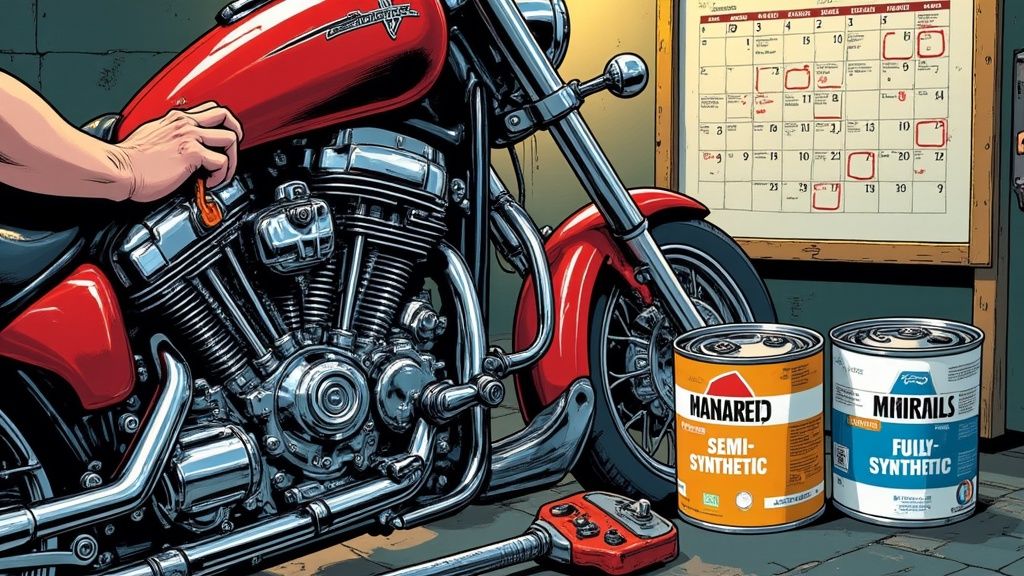
The Ultimate Guide to Motorcycle Oil Change Intervals: When and Why to Service Your Bike
Understanding Different Types of Motorcycle Oil
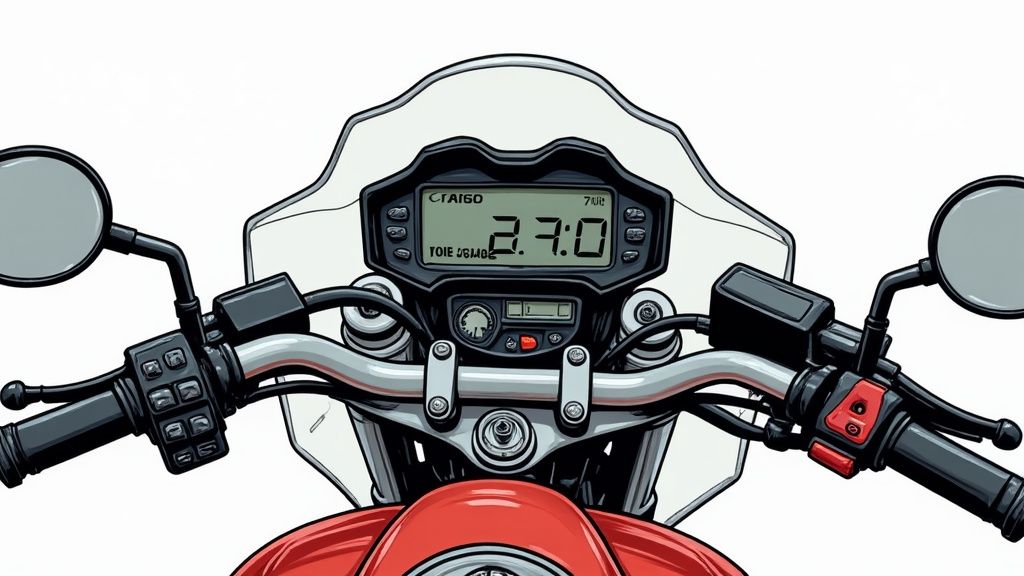
Picking the right oil for your motorcycle matters immensely for engine health and lifespan. Beyond just brand names, understanding the basic oil types helps you make smarter maintenance decisions. There are three main categories to know about: mineral oil, semi-synthetic oil, and fully synthetic oil. Each type has specific properties that affect how well it works and how long it lasts.
Mineral Oil: The Traditional Choice
Made from refined crude oil, mineral oil offers a basic level of engine protection at a lower cost. It works well for older motorcycles and engines with simpler needs. The main drawback is that it breaks down more quickly than other options, so you’ll need more frequent oil changes to keep your engine properly protected.
Semi-Synthetic Oil: A Balanced Approach
Semi-synthetic oil combines mineral and synthetic bases to deliver better performance at a middle-range price point. This blend protects better than pure mineral oil and lets you go longer between changes. Many riders choose semi-synthetic oil because it strikes a good balance between quality and cost.
Fully Synthetic Oil: Peak Performance and Protection
Engineered for maximum performance, fully synthetic oil stands at the top of motorcycle oil technology. It handles extreme heat and pressure better than other types and maintains its protective qualities much longer. This makes it perfect for high-performance bikes and challenging riding conditions. The advanced formulation also helps keep engines cleaner by preventing deposit buildup.
Oil change timing depends heavily on which type you use. Mineral oil typically needs changing every 2,000 to 3,000 miles or yearly. Semi-synthetic oil can last 5,000 to 6,000 miles, while fully synthetic oil stretches to 7,000 to 10,000 miles between changes. These differences come from how quickly each type breaks down during use. Want to learn more? Check out this detailed guide on oil change intervals.
Your choice of oil type and careful attention to change intervals helps maintain your engine’s performance and durability. Consider your motorcycle’s specific needs, how you ride, and your budget when deciding. Using a maintenance tracking tool can help you stay on schedule with oil changes and other important service items.
How Motorcycle Age and Condition Impact Oil Change Frequency
Every motorcycle has unique maintenance needs based on its age and condition. Just as vehicles age over time, their maintenance requirements evolve. Understanding how your bike’s oil change needs shift with age helps maintain peak performance and engine longevity.
Age: A Key Factor in Oil Change Intervals
A motorcycle’s age significantly affects its oil requirements. Older engines were built for mineral-based oils and may develop leaks if switched to modern synthetic oils. In contrast, new high-performance engines need semi-synthetic or fully synthetic oils to handle increased heat and stress. Each bike has specific needs based on its engineering and design era.
Proper oil selection is critical for both old and new motorcycles. Some modern street bikes need their first oil change at just 750 miles. Always check your owner’s manual for the exact recommendations for your model. Learn more about motorcycle oil change timing.
Spotting the Signs of Wear and Tear
As mileage increases, engine parts naturally wear down. This leads to more oil consumption and faster contamination. Watch for these key warning signs:
- Unusual engine noises
- Reduced performance
- Changes in oil color or texture
- Increased oil consumption
Regular oil level checks become even more important for older motorcycles.
Adapting Your Maintenance Schedule
Create a maintenance plan that fits your specific motorcycle. Consider:
- The bike’s age and mileage
- Your typical riding conditions
- Any changes in performance
- Service history
Keep detailed maintenance records to track oil changes and service work. This helps identify patterns and prevent major repairs before they happen.
Transitioning Your Maintenance Strategy
As your motorcycle ages, update your maintenance approach accordingly. This may include:
- Switching to different oil types
- More frequent oil changes
- Regular inspections for leaks
- Additional wear monitoring
Work with a trusted mechanic to develop the right care plan for your aging motorcycle. This ensures your bike gets the proper maintenance as its needs change over time.
The Role of Riding Conditions and Style
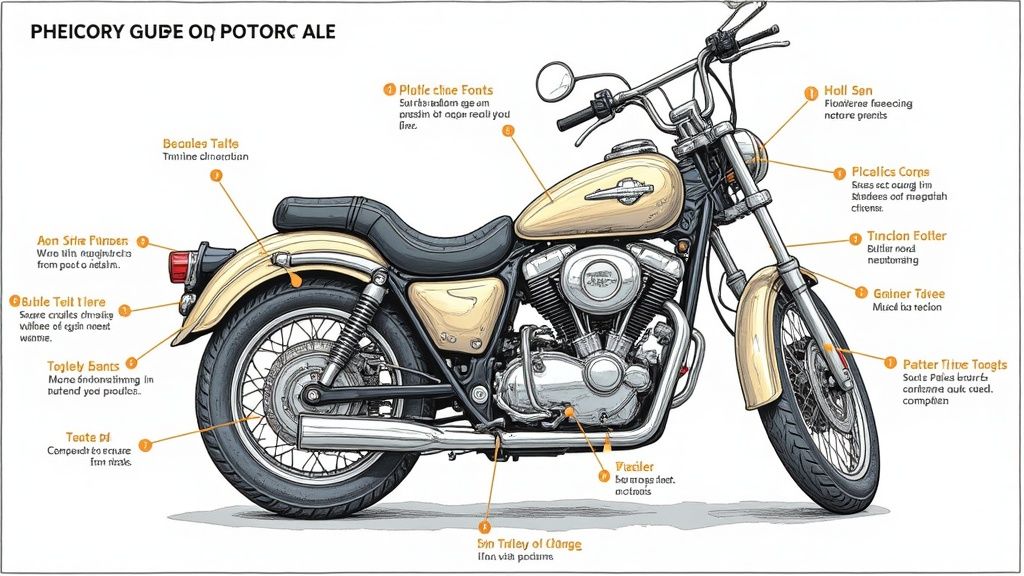
Every motorcycle requires a unique oil change schedule. Just like running shoes wear differently based on usage, your bike’s oil needs vary based on how and where you ride. Demanding conditions mean more frequent oil changes to maintain optimal engine performance.
Environmental Factors: Heat and Dust
High temperatures cause oil to break down more quickly. If you frequently ride in hot weather, especially at high speeds, you’ll need more frequent oil changes. Similarly, dusty roads and dirty conditions contaminate oil faster, requiring shorter intervals between changes.
Riding Intensity: Racing vs. Cruising
Your riding habits directly affect oil life. Track days and off-road adventures create more engine heat and stress than casual street riding. High-performance riding can reduce oil life by up to 50% compared to regular cruising. If you ride aggressively, plan for more frequent oil changes.
Seasonal Changes: Winter Storage and Summer Rides
The changing seasons impact your maintenance needs. Winter storage can lead to moisture buildup in your oil. It’s essential to change your oil before storing your bike and again when you bring it out for spring. Summer heat also speeds up oil degradation, so adjust your schedule accordingly.
Adapting Your Schedule: Real-World Riding
To create an effective oil change plan, consider these key factors:
- Riding Environment: Highway miles, city traffic, or off-road adventures
- Riding Style: Casual cruising or aggressive performance
- Weather Conditions: Temperature extremes and seasonal changes
Use your owner’s manual as a starting point, then adjust based on your specific situation. Auto Service Logger helps track your maintenance history and riding conditions. Regular oil changes based on your actual usage patterns will help prevent engine problems and extend your motorcycle’s life.
Signs Your Motorcycle Needs an Oil Change
Keeping fresh oil in your motorcycle is essential for its performance and longevity. While following the recommended oil change schedule is important, your bike may need fresh oil sooner based on how and where you ride. Understanding these key warning signs helps you prevent expensive engine damage.
Listening to Your Engine
Pay attention to changes in your engine’s sound. Normal engine operation should be smooth and relatively quiet when the oil is doing its job. As oil breaks down, metal parts begin rubbing together, creating unusual noises. Watch out for clattering, knocking, or ticking sounds - these often mean it’s time for fresh oil, even if you haven’t hit the mileage interval.
Observing Performance Changes
Your motorcycle will tell you when it needs an oil change through how it rides. Poor oil leads to reduced engine performance that you’ll notice while riding. Signs include slower acceleration, decreased fuel economy, and a general sluggish feel. While these changes may start subtly, they become more obvious as oil quality degrades further.
Visual Inspection: Checking the Oil
Regular oil checks give you vital information about your engine’s health. Check the dipstick level and oil condition - fresh oil should be clean and amber-colored. Dark, murky, or gritty oil means contaminants have built up and it’s time for a change. Low oil levels or oil that feels rough between your fingers indicates potential engine damage if not addressed.
Monitoring Oil Consumption
Track how much oil your bike uses between changes. While some consumption is expected, a sudden increase often points to mechanical issues like worn piston rings or valve seals. Having to add oil more frequently than usual suggests you need both an oil change and possibly a mechanic’s inspection.
Staying Proactive with Auto Service Logger
Keeping detailed maintenance records helps you spot potential issues early. Auto Service Logger makes it simple to track oil changes, monitor consumption patterns, and schedule future service. The app helps identify when your bike needs attention before problems develop. Regular oil monitoring combined with good record-keeping means fewer surprise repairs and a longer-lasting motorcycle.
Creating Your Personal Oil Change Schedule
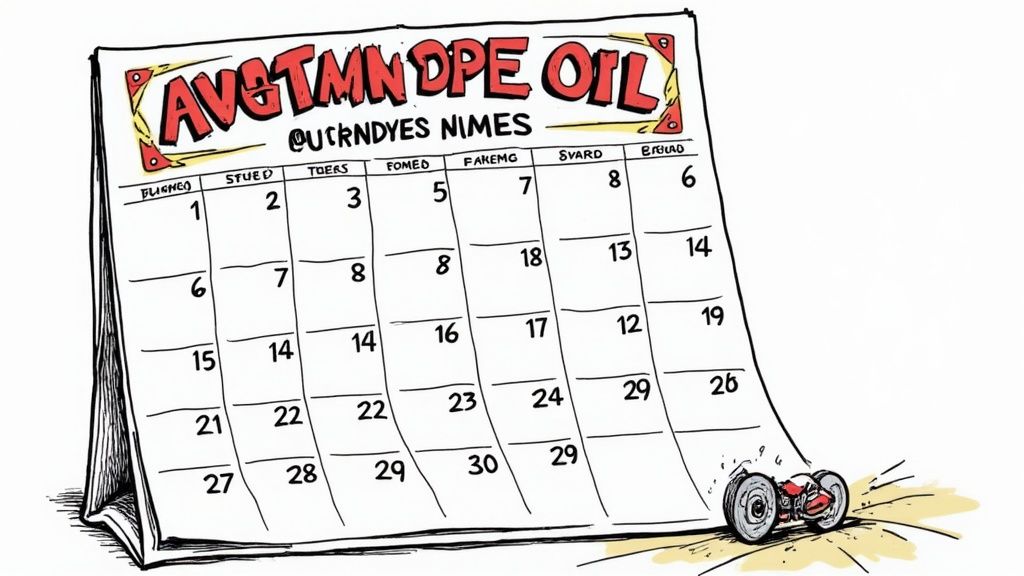
Standard motorcycle oil change intervals provide a good baseline, but they don’t account for each rider’s unique situation. For proper motorcycle care, it’s essential to develop a schedule that matches your specific needs. By considering your bike, riding style, and environment, you can create a maintenance plan that works best for you.
Factors to Consider for Your Schedule
Several key elements determine how often you should change your motorcycle’s oil. Understanding these helps create an effective maintenance routine that protects your engine.
- Oil Type: Traditional mineral oil needs more frequent changes than synthetic versions. Synthetic oils are designed to maintain their protective qualities longer under high temperatures.
- Motorcycle Age: Engines with more miles often need shorter oil change intervals. New motorcycles may have specific requirements listed in their owner’s manual.
- Riding Conditions: Hot weather, dusty roads, and city traffic cause oil to break down faster. These situations call for more frequent oil changes.
- Riding Style: Hard acceleration and high-speed riding create more engine heat and stress, requiring more oil changes than casual cruising. Like running sprints versus jogging - more intense activity needs more maintenance.
Building Your Maintenance Tracking System
Keeping accurate records ensures you change your oil on schedule. You can choose between digital and paper-based tracking methods.
- Digital Tools: Applications like Auto Service Logger help you track mileage, set reminders, and record service history. These features make it easy to stay on top of maintenance.
- Traditional Logging: A physical notebook works well for recording oil changes, dates, and mileage. While manual, it provides a reliable record you can easily reference.
Developing Your Personalized Calendar
After evaluating the factors affecting your oil life and picking a tracking method, you can build your maintenance calendar. This schedule should adapt as your riding habits change.
- Start with the Manufacturer’s Recommendation: Your owner’s manual provides the basic oil change interval.
- Adjust Based on Your Riding: Reduce the interval for harsh conditions or aggressive riding. For gentle riding in good conditions, you might extend it slightly while keeping engine health the top priority.
- Regularly Review and Adjust: Check your schedule every few months, especially after long trips or changes in how you ride. This keeps your maintenance aligned with current needs.
A custom schedule combined with good record-keeping helps maintain your motorcycle properly. This careful attention to maintenance helps your engine last longer and run better.
Common Oil Change Mistakes to Avoid
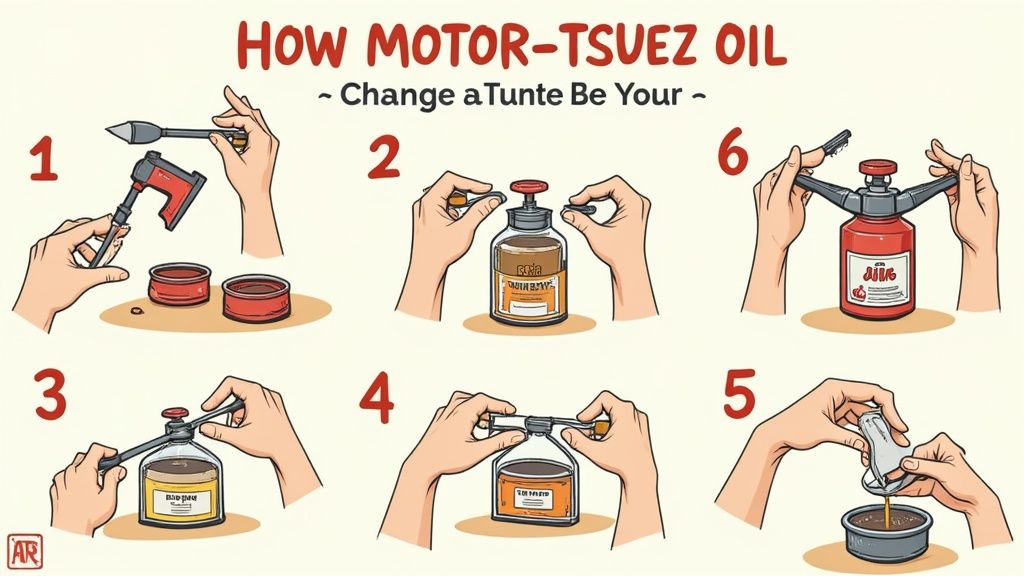
Proper oil changes are essential for keeping your motorcycle running well. While the process may seem straightforward, several common mistakes can impact your bike’s performance. Understanding these errors helps you avoid expensive repairs and maintain your motorcycle properly.
Choosing the Wrong Oil Type
Many riders make the mistake of using incorrect oil. Your motorcycle needs specific oil that matches manufacturer requirements - using car oil or the wrong type can damage the engine and cause clutch problems. Check your owner’s manual for the right viscosity rating and oil type (mineral, semi-synthetic, or fully synthetic) to keep your engine properly lubricated.
Ignoring the Oil Filter
The oil filter removes harmful particles from your engine oil. Skipping the filter change while putting in fresh oil limits its cleaning ability. Just like you wouldn’t put clean air through a dirty air filter, fresh oil needs a new filter to work effectively.
Overfilling or Underfilling
Adding too much or too little oil creates problems for your engine. Excess oil builds up pressure, while insufficient oil leads to poor lubrication and wear. Think of it like tire pressure - the right amount is crucial for proper function. Always verify oil levels with your dipstick after filling.
Improper Disposal of Used Oil
Used motor oil contains harmful substances that should never go down drains or onto soil. This damages the environment and may result in penalties. Take your used oil to local auto parts stores or service centers that offer recycling. Proper disposal protects our environment.
Neglecting Scheduled Changes
Regular oil changes at recommended intervals are vital, even if the oil looks fine. Follow your motorcycle’s maintenance schedule and check oil levels regularly between changes. This prevents engine problems before they start.
Over-Tightening the Drain Plug
Using too much force when tightening the drain plug can damage the oil pan and create leaks. Use a torque wrench and follow the specifications in your owner’s manual. This ensures a proper seal without causing damage.
Avoid these mistakes by following proper maintenance procedures. Keep detailed records of your oil changes and other service work using a tool like Auto Service Logger. Good documentation helps you stay on schedule and track your bike’s maintenance history. Start logging your motorcycle maintenance today with Auto Service Logger!